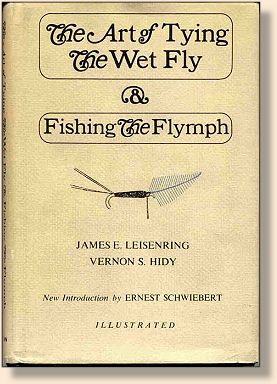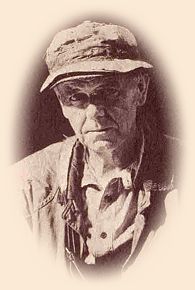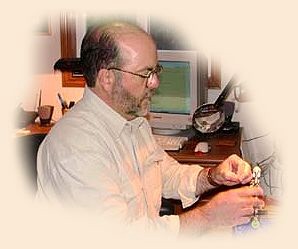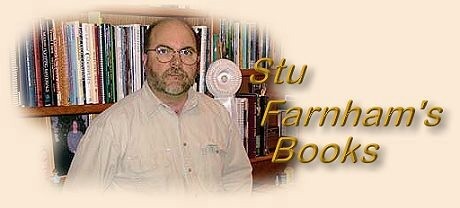|
The Internet is a powerful resource. It provides us instant
access to information, and brings us together via email,
bulletin boards, chat rooms, and instant messaging. FAOL
is a wonderful example of the Internet at its best. The Internet,
however, will never replace the printed page.
I've loved books and fishing since my youngest years, although
I did not start fly fishing until 1993. This column will give
me an opportunity to share reviews of some of my favorite fly
fishing and tying books (and some that are not such favorites)
with my friends here at FAOL. My library reflects my tastes
and interests, and so will this column. It will be heavily
slanted towards cold water fishing and tying for trout and
steelhead, and won't touch much on areas of which I know little,
such as warm or salt water fishing.
I hope that these reviews will motivate some of you to pick up
a good book, on this or any subject, and read.
~ Stu Farnham
The Art of Tying the Wet Fly & Fishing the Flymph
 The Art of Tying the Wet Fly & Fishing the Flymph
The Art of Tying the Wet Fly & Fishing the Flymph
James E. Leisenring and Vernon S. Hidy
second edition, 1971
Crown Publishers, New York
It is fitting that this small book (160 5"x7" pages, 30 of
which are forwards and introductions) is dedicated "To G.E.M.
Skues Master Angler and Talented Writer." This is the first
book in the North American fly angling canon to be devoted
to the tying and fishing of subsurface flies. In fact,
Leisenring is often referred to as "the American Skues,"
and the two corresponded by mail for a number of years prior
to Skues' death in 1949. Ernest Schwiebert's introduction to
the 1971 edition does a fine job of placing Leisenring and
Hidy's work in the historical contexts of both UK and North
American fly angling literature.
 The book was originally published in 1941 as The Art of
Tying the Wet Fly, by Leisenring "as told to Vernon S.
['Pete'] Hidy. When Nick Lyons approached Hidy about printing
a second edition in 1971, twenty years after Leisenring's death,
Hidy was asked to update the original text and to add his coda
on fishing the flymph. Leisenring favored wingless wet flies;
Hidy coined the name 'flymph' because he felt these imitations
represented the emerging stage, between the nymph and the adult
fly.
The book was originally published in 1941 as The Art of
Tying the Wet Fly, by Leisenring "as told to Vernon S.
['Pete'] Hidy. When Nick Lyons approached Hidy about printing
a second edition in 1971, twenty years after Leisenring's death,
Hidy was asked to update the original text and to add his coda
on fishing the flymph. Leisenring favored wingless wet flies;
Hidy coined the name 'flymph' because he felt these imitations
represented the emerging stage, between the nymph and the adult
fly.
![Vernon S. ['Pete'] Hidy](flymphauthor2.jpg) This is mostly a fly tier's book. Only a single chapter each
from the wet fly and flymph sections deals with methods. The
book is notable for one of the methods it introduces: the
Leisenring lift, and the chapter which describes it is a
scant 3 ½ pages long. Fished by many today as a searching
method during early stages of a hatch, Leisenring employed
it in more limited circumstances, fishing at relatively
short distances to spotted fish.
This is mostly a fly tier's book. Only a single chapter each
from the wet fly and flymph sections deals with methods. The
book is notable for one of the methods it introduces: the
Leisenring lift, and the chapter which describes it is a
scant 3 ½ pages long. Fished by many today as a searching
method during early stages of a hatch, Leisenring employed
it in more limited circumstances, fishing at relatively
short distances to spotted fish.
The picture of Leisenring that emerges from this book is
of a meticulous fly tier whose choices were made based on
experience and careful observation. While the chapters on
tools and hooks are pretty much dated, there is good
information in the chapter on hackles, which the modern
tier of wingless wets, flymphs, and soft hackles will find
useful. Jim had very specific opinions about bodies,
opinions which were validated 40 years later by the observations
of Gary LaFontaine.
"Since the bodies of most trout stream insects are somewhat
translucent the fly tier must choose materials to imitate
them with qualities which produce or reproduce those little
sparkles of light which transmitted light gives to the bodies
of natural insects," he says in the opening paragraph of the
chapter on body materials. Leisenring preferred dubbed fur
bodies as he felt that other materials such as stripped
quills lacked the necessary translucence. Jim had his own
method of preparing pre-spun dubbed bodies much like those
made with dubbing loops. He prepared a number of bodies at
one time, in colors blended to match his streamside
observations of the naturals, and save them on cards
for later use in tying.

Chapters are devoted to the details of his method of tying
winged wets and nymphs, accompanied by clear pen and ink
illustrations and followed by a chapter detailing his
favorite fly patterns.
The first couple of chapters of "Fishing the Flymph" describe
the importance of the emerging insect as a trout food and so
also to the fly fisherman. Hidy dismisses the notion that
wet flies are strictly a searching pattern, describing the
use of flymphs in hatch matching situations. Rick Haefle's
March Brown flymph is perhaps my favorite fly for this early
season hatch in the Pacific Northwest. Since March Browns
often emerge on cold, rainy days, they can be slow to escape
the surface film, and so are ideally matched by a flymph
fished damp.

The final chapter describes methods for fishing the flymph.
I have found that flymphs can be fished upstream as dry flies,
then, pulled beneath the surface and fished damp or wet when
drag sets in.
Copies of the 1941 edition are both scarce and expensive. Copies
of the 1971 edition are easier to find, and there is rumor that
a reprint in the works. ~ Stu Farnham
About Stu
 Stu Farnham is a New Englander by birth, who was transplanted to
and put down roots in Oregon in the early 1990s. A software
engineering manager by vocation, he can be found in his spare
time chasing trout and steelhead in the rivers of the Pacific
Northwest, chasing his four Gordon Setters (who in turn are
chasing chukar), tying flies, reading, or working on his website.
Colleen, his long suffering wife of 28 years, is a professionally
trained personal chef.
Stu Farnham is a New Englander by birth, who was transplanted to
and put down roots in Oregon in the early 1990s. A software
engineering manager by vocation, he can be found in his spare
time chasing trout and steelhead in the rivers of the Pacific
Northwest, chasing his four Gordon Setters (who in turn are
chasing chukar), tying flies, reading, or working on his website.
Colleen, his long suffering wife of 28 years, is a professionally
trained personal chef.
|

 The Art of Tying the Wet Fly & Fishing the Flymph
The Art of Tying the Wet Fly & Fishing the Flymph

 Stu Farnham is a New Englander by birth, who was transplanted to
and put down roots in Oregon in the early 1990s. A software
engineering manager by vocation, he can be found in his spare
time chasing trout and steelhead in the rivers of the Pacific
Northwest, chasing his four Gordon Setters (who in turn are
chasing chukar), tying flies, reading, or working on his website.
Colleen, his long suffering wife of 28 years, is a professionally
trained personal chef.
Stu Farnham is a New Englander by birth, who was transplanted to
and put down roots in Oregon in the early 1990s. A software
engineering manager by vocation, he can be found in his spare
time chasing trout and steelhead in the rivers of the Pacific
Northwest, chasing his four Gordon Setters (who in turn are
chasing chukar), tying flies, reading, or working on his website.
Colleen, his long suffering wife of 28 years, is a professionally
trained personal chef.
 The book was originally published in 1941 as The Art of
Tying the Wet Fly, by Leisenring "as told to Vernon S.
['Pete'] Hidy. When Nick Lyons approached Hidy about printing
a second edition in 1971, twenty years after Leisenring's death,
Hidy was asked to update the original text and to add his coda
on fishing the flymph. Leisenring favored wingless wet flies;
Hidy coined the name 'flymph' because he felt these imitations
represented the emerging stage, between the nymph and the adult
fly.
The book was originally published in 1941 as The Art of
Tying the Wet Fly, by Leisenring "as told to Vernon S.
['Pete'] Hidy. When Nick Lyons approached Hidy about printing
a second edition in 1971, twenty years after Leisenring's death,
Hidy was asked to update the original text and to add his coda
on fishing the flymph. Leisenring favored wingless wet flies;
Hidy coined the name 'flymph' because he felt these imitations
represented the emerging stage, between the nymph and the adult
fly.![Vernon S. ['Pete'] Hidy](flymphauthor2.jpg) This is mostly a fly tier's book. Only a single chapter each
from the wet fly and flymph sections deals with methods. The
book is notable for one of the methods it introduces: the
Leisenring lift, and the chapter which describes it is a
scant 3 ½ pages long. Fished by many today as a searching
method during early stages of a hatch, Leisenring employed
it in more limited circumstances, fishing at relatively
short distances to spotted fish.
This is mostly a fly tier's book. Only a single chapter each
from the wet fly and flymph sections deals with methods. The
book is notable for one of the methods it introduces: the
Leisenring lift, and the chapter which describes it is a
scant 3 ½ pages long. Fished by many today as a searching
method during early stages of a hatch, Leisenring employed
it in more limited circumstances, fishing at relatively
short distances to spotted fish.